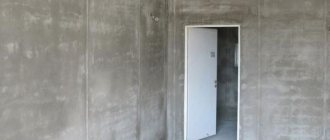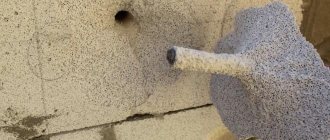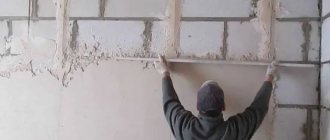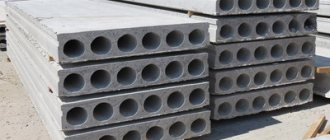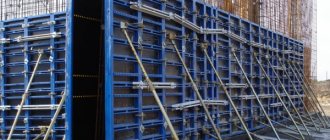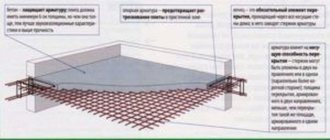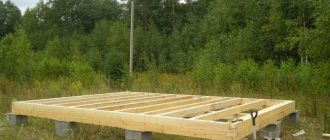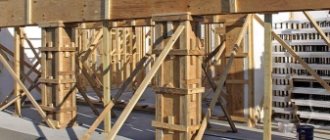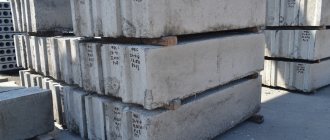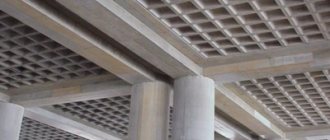If you have to plaster a large area, then to obtain a high-quality and even result you need to use beacons on the plaster. They will help indicate the level and make the work easier. What is a lighthouse, what types are there and how best to work with them to get the desired result, all these points will be discussed further.
What is a plaster beacon
Plastering walls using beacons is a technique familiar to every master. Beacons (profiles, guides) are devices made of different types of materials that serve as limiters for the putty layer. They are designed for a more even and beautiful application of the plaster mixture, to reduce time and labor costs for leveling surfaces. Previously, all craftsmen used homemade beacons; now there are ready-made disposable and reusable products on sale.
The use of beacons has many advantages. They are inexpensive, resistant to mechanical stress, flexible and easy to use. Thanks to the beacons, even a thick layer of finishing will be even, whereas without their use you will have to constantly check the correctness of the plastering level. The builder applies the solution, focusing on the position of the profiles, so they are usually placed over the entire surface to be plastered.
Applying the plaster solution along the beacons allows you to create a perfectly flat surface
Preparing the surface for installation
Before installing the beacons, you need to prepare the surface itself, otherwise after a short period of time the plaster may fall off. It is necessary to remove all dirt, remove old finishes, and, if present, clean the surface of mold and fungi, and any existing metal elements. Cracks and other defects are covered.
If the surface is too smooth, then it needs to be sanded to obtain better adhesion to the material.
A primer is applied to the dry surface and, if required, the wall is reinforced.
It is necessary to remove all dirt and remove old finishes.
Types of lighthouses
Depending on the material and properties, the beacons differ from each other. They all have their own characteristics and specific application.
Metal
This is the most popular version of profiles available in construction stores. Installation of metal beacons is the simplest; no special training is required. They are most often not removed after work is completed. There are metal beacons of different sizes on sale, with small ones used infrequently, while medium and large ones are most in demand.
Perforated beacon profile
Since a thin profile is used for the manufacture of products, it can be easily cut with scissors according to the required dimensions, which is a definite advantage for the craftsman. The disadvantages of metal beacons include the risk of rusting. Such products are made from ordinary carbon steel, which is prone to corrosion. In some cases, this leads to the appearance of unsightly red spots on the finish. In addition, if the beacons are too flexible and thin, to fill them you will have to prepare a special solution to strengthen the structure, or additionally use clips.
Wooden
Such devices are made from rectangular wooden slats with a channel-shaped profile. After the plaster hardens, they are removed. It is necessary to saturate each lighthouse with a water-repellent agent in advance, otherwise the wood may warp and bend, and the coating will not be even.
Wooden guides for applying plaster
Plastic
Such profiles are made of durable plastic. Their standard thickness is 3, 6, 9 mm, length - 3 meters, although there are other options on sale. The advantages of plastic beacons are undeniable:
- light weight, easy to transport and store;
- strength is not lower than that of metal products;
- non-susceptibility to deformation, return to original shape after bending;
- no risk of corrosive destruction or rotting.
PVC profile for leveling
Plastic guides also have disadvantages. They are less resistant to shock loads than their metal counterparts. In addition, the products are not suitable for facade decoration, since they lose strength under the influence of sub-zero temperatures. They require strictly correct fixation on the surface, otherwise they will bend when moving the trowel.
Reusable steel
Beacons, which can be removed and reused after plastering, are an order of magnitude more expensive than disposable ones. They are made of very durable metal (usually stainless steel or galvanized), they will never move even when a thick layer of the mixture is applied. Due to the high price, such beacons are most often used by professional builders.
Reusable steel beacon with fastenings
Homemade
Craftsmen often use various homemade devices that act as guides. For example, when finishing wooden surfaces, wooden blocks of the required size are used, which are easily attached with self-tapping screws. Experienced finishers even make beacons from the mixture, applying it in “heaps” according to the level or on the heads of pre-screwed screws. There is no need to dismantle them, because they will be completely hidden by plaster.
Installation of self-tapping screws for leveling walls
Strings
These products are also homemade analogues of purchased beacons. To install them, screw in self-tapping screws and stretch a thin wire or string between them, checking the correct location with a level. The free space that has formed under the string is filled with plaster. The strings must be removed before the solution has completely hardened. If you make a mistake and install the string beacons incorrectly, you can end up with a crooked surface.
Set of string beacons for plaster
Laser
Such “beacons” are projected onto walls using levels or laser levels. Such devices create marking lines in one plane. If you install the device and set the vertical plane parallel to the position of the base, the laser beam on the floor will outline a line to adjust the thickness of the finishing layer. Using this mark, you can install self-tapping screws with a certain height.
Using a laser level to level the plane
Purpose
The main function of the lighthouse structure is to level the mixture along the guides, but profiles are often used to perform other finishing work.
Purpose and use of beacons:
For all applications, profiles made of different materials can be used. Galvanized metal, aluminum and plastic can be used both one-time and to create additional reinforcement of the coating, and reusable when elements are dismantled. It is not recommended to leave metal beacons inside unless they are intended for that purpose. During the operation of buildings, the coating can accumulate moisture, which will lead to corrosion and peeling of the finishing layer from the base.
Sizes and shapes
There are guides of various sizes on sale - from 3 mm to 3 cm. As for the length of the products, it can be 1-6 meters. They must be selected depending on the depth of the depressions and the height of the convexities, that is, on the degree of surface roughness. The more mixture you have to apply, the larger the limiters should be. Devices 2-3 meters long are usually used for renovations in residential buildings and apartments. Six-meter profiles are more suitable for plastering warehouses, industrial premises, as well as for exterior finishing.
Straight guides are perforated products that have a V-shaped protrusion that will serve as a guide during operation. Corner beacons have the same protrusion, but in parallel they are equipped with shelves located at right angles. They are used to level and increase the strength of external corners. Corner profiles do not have great rigidity, so during installation it is necessary to regularly check the straightness of their installation.
Dimensions of plaster beacons M6 and M10
Extraction
When the 3 mm, 6 mm and 10 mm thick products, as in the photo, are no longer needed, they will need to be pulled out. It is better to carefully cover the resulting voids in the places where the profiles were located with a solution containing alabaster.
Let's sum it up
Beacons of different sizes are an extremely relevant invention that simplifies finishing work and reduces the cost of purchasing plaster. When choosing such products, you need to pay attention to their evenness and the quality of the material from which they are made.
Source
Materials and tools for finishing
To install the guides and apply the plaster mixture, different tools may be required depending on the specific type of product and the technology used. Typically, an exhaustive list of devices and consumables looks like this:
- building level (any) and plumb line;
- strong thread or fishing line;
- self-tapping screws;
- dowels;
- screwdriver;
- capacity;
Tools for plastering an apartment
- drill with mixer attachment;
- grater or grater;
- rule;
- spatulas;
- Master OK.
You should also purchase the beacons themselves, which are selected in accordance with the expected thickness of the coating. As for the length, it is better for beginners to take standard 3-meter products. If mechanized plastering is intended, an apparatus for applying the mixture (plaster ladle or gun) is also prepared.
Installation of beacons
Plastering work begins with markings, then profiles are installed, and then they begin the process of plastering the surfaces.
Wall marking
The marking is applied on an already prepared base, which has been cleaned of old falling off coating, freed from rot, mold and thoroughly primed. To set up beacons, you can use the simplest method - manual marking, which is carried out in the following sequence:
- They retreat from the corner by 30 cm. Draw a strictly vertical line along the level, repeat the operation on the second side of the wall.
- Measure the distance between the lines, divide it by 1.5 meters, thus calculating the number of required beacons.
- The finished accessories are cut so that they are 30 cm shorter than the height of the ceilings.
Wall marking scheme for installing beacons
- Holes are drilled at the top and bottom of the lines and self-tapping screws are placed in them. Draw the entire area of the wall with lines every 1.5 meters.
- Screws are screwed into the holes on the first two strips and the threads are pulled between them. Where the thread will intersect with the other lines, fasteners are also placed.
- Calculate the level of location of the screws. To do this, add up the wall collapse indicator, the thickness of the lighthouse and add a small margin (about 0.5 cm). The self-tapping screws are aligned to this value.
- Stretch the threads diagonally and pass the beacon under this plane (it should only slightly touch the thread).
Professionals prefer to install beacons using a laser level. With its help, they find a surface blockage by first placing the device against the wall and turning on the cross-shaped beam. This indicator will give an idea of how thick the plaster layer should be. Then, using a level, vertical lines are drawn on the wall every 1.5 meters, onto which the beacons are subsequently placed using glue or screws.
Installation of beacons
Each type of profile has its own installation and wall mounting features, but all of them are suitable for any type of base.
Installation of metal and wooden beacons
Such beacons are placed at a distance of 120-170 cm from each other (the standard indicator is 1.5 meters). The outer guides are placed 30 cm from the walls, but this distance can vary depending on individual conditions and be 15-20 cm.
If the marking was done correctly, then further actions are not difficult. Check again that the screws are positioned correctly using a level. If necessary, adjust their location. Next, profiles or wooden slats are placed on the heads of the screws so that they rest along the entire length, and secured with mortar. The latter is prepared in advance, and then the beacons are pressed with a long rule to the head of the screws. Excess solution will immediately come out through the perforation. After the initial setting of the solution, fix the profiles with dowels or add a cement mixture so that it holds them securely on the wall.
Installation of beacons from solution
This method works well if the solution layer is small. It is ideal for gypsum mixtures. The preliminary stage (marking) is also carried out, and then the order of work will be as follows:
- mix the solution and apply it in heaps directly onto the heads of the self-tapping screws;
- after the solution has set slightly, the excess protruding from the caps is removed;
- as the marks harden, apply a rule to them vertically, throw the solution into the space between it and the wall;
- tap the rule with a hammer to level the strip of mortar, then carefully remove the device;
- when voids, holes, or potholes appear, rub out all defects with a small trowel;
- repeat these steps throughout the applied markings.
Homemade lighthouse made of gypsum plaster
Installation of string beacons
This technique is even simpler than those already described. When marking, a steel wire (thread, fishing line) is immediately pulled onto the aligned beacons, which will serve as a guide for leveling the wall. Afterwards, putty is applied so that it protrudes slightly beyond the wire, and the excess is removed.
Installation of strings for plastering walls
Applying the solution along the beacons
The prepared mixture is applied using a trowel, spatula, or trowel between the installed beacons. It is very convenient to use a ladle for this purpose, but if you don’t have one, you can simply throw the product on with a spatula. The finished layer should protrude slightly beyond the tops of the profiles.
Next, stretch the solution using zigzag movements from bottom to top. After completing the work on the entire base and setting the coating, the beacons are removed or left, if possible. The grooves from the products are filled with plaster of a thicker consistency.
Construction of slopes and corners
The internal corners are formed with a corner spatula. They are ironed, brought to perfect evenness, checking with a level. Door and window slopes are made with inward expansion. Obtuse corners are smoothed out with a wooden lath or shaped using a special profile for slopes.
Plastering external corner
Final alignment
Rubbing is carried out as the final stage of finishing. All actions are carried out only after the solution has completely dried. You will need a similar mixture, but with a thinner consistency. The procedure is as follows:
- Sprinkle the base with a little water;
- Apply the liquid solution to a grater and spread it in a thin layer;
- place the tool at an angle of 45 degrees, carefully rub the surface literally 1-2 square meters;
- The excess solution accumulated on the grater is removed.
Finishing plaster with a trowel
If tiling is planned, then grouting work is not necessary. Irregularities will only improve the adhesion of the ceramics to the base.
